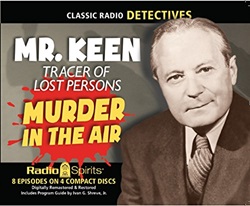
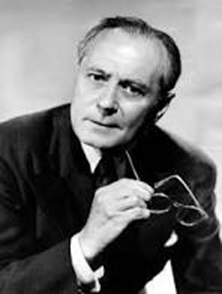 Mr. Keen, Tracer of Lost Persons (1937-1955) aired “The Nightmare Murder Case” on December 14, 1944. This is only the 2nd episode of Mr. Keen we have offered, the first coming in late January of this year. A reprise of the introductory material from that initial show is in order for newcomers, as well as for those familiar with the show who may need a quick reminder of the show’s basic concept.
Mr. Keen, Tracer of Lost Persons (1937-1955) aired “The Nightmare Murder Case” on December 14, 1944. This is only the 2nd episode of Mr. Keen we have offered, the first coming in late January of this year. A reprise of the introductory material from that initial show is in order for newcomers, as well as for those familiar with the show who may need a quick reminder of the show’s basic concept.
The program was the brainchild of, and produced by the team of Frank and Anne Hummert, who were inspired by the 1906 novel The Tracer of Lost Persons by American author and artist Robert W. Chambers.
Mr. Keen, Tracer of Lost Persons holds the distinction of being the longest running of any detective show on radio, with its 1,690 broadcasts far outstripping its fellow detective shows, including (according to wikipedia): “Nick Carter, Master Detective (726 broadcasts), The Adventures of Sherlock Holmes (657) and The Adventures of the Falcon (473).” Unfortunately, out of the almost 1,700 episodes over its 18-year run, fewer than 60 shows have survived.
Bennett Kilpack (1883-1962, photo top right) starred as Mr. Keen, who came to be known as “the kindly old investigator,” and Jim Kelly would play the role of Keen’s Irish partner Mike Clancy. From 1937-1942 the NBC network aired the show three times a week in short 15-minute episodes, and true to the show’s name involved Mr. Keen tracking down people who had disappeared for one reason or another and had left families, homes, or jobs behind. In November of 1943 (and now with the CBS radio network since 1942) the format changed to full half hour shows, and Mr. Keen’s skills were expanded to include those of a full-fledged investigator, one who used his intellect and cunning not only to find missing persons, but to bring murderers to justice as well. Kilpack played Keen for nearly 1,300 episodes for 13 years, at which time he made his final appearance on October 26, 1950. Following his “retirement” from the show (its 1,314th broadcast), Mr. Keen would be played by Arthur Hughes and Phil Clarke, with the program’s final episode airing on April 19, 1955. While the show absorbed and survived criticism in some quarters for being written to a very broad-based (i.e., lowest common denominator) audience, it enthralled such a large swath of the listening public on a regular basis, providing it with much needed relief from the day to day grind, that it lasted for nearly 20 years, even unto the dawn of the television age.
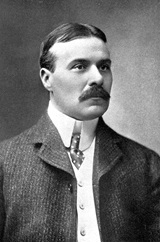
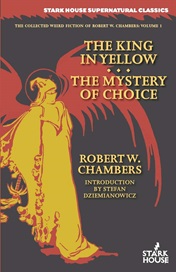 Before teasing this week’s episode, I’d like to give a nod to the author of the book who gave inspiration to the Hummett’s for Mr. Keen, Tracer of Lost Persons. Robert W. Chambers (1865-1933) was a prolific author who wrote dozens of novels, short stories, more than a handful of children’s books, and whose stories of his own work were collected in several volumes, with a number of his detective and/or supernatural tales reprinted in numerous anthologies. Chambers’ most famous work for fans of the fantasy genre is perhaps his 1895 collection of 9 stories, The King in Yellow. His wikipedia page provides the following paragraph of this singular work: “The book contains nine short stories and a sequence of poems; while the first stories belong to the genres of supernatural horror and weird fiction, The King in Yellow progressively transitions towards a more light-hearted tone, ending with romantic stories devoid of horror or supernatural elements. The horror stories are highly esteemed, and it has been described by critics such as E. F. Bleiler and T. E. D. Klein as a classic in the field of the supernatural. Lin Carter called it ‘an absolute masterpiece, probably the single greatest book of weird fantasy written in this country between the death of Poe and the rise of Lovecraft,’ and it was an influence on Lovecraft himself.”
Before teasing this week’s episode, I’d like to give a nod to the author of the book who gave inspiration to the Hummett’s for Mr. Keen, Tracer of Lost Persons. Robert W. Chambers (1865-1933) was a prolific author who wrote dozens of novels, short stories, more than a handful of children’s books, and whose stories of his own work were collected in several volumes, with a number of his detective and/or supernatural tales reprinted in numerous anthologies. Chambers’ most famous work for fans of the fantasy genre is perhaps his 1895 collection of 9 stories, The King in Yellow. His wikipedia page provides the following paragraph of this singular work: “The book contains nine short stories and a sequence of poems; while the first stories belong to the genres of supernatural horror and weird fiction, The King in Yellow progressively transitions towards a more light-hearted tone, ending with romantic stories devoid of horror or supernatural elements. The horror stories are highly esteemed, and it has been described by critics such as E. F. Bleiler and T. E. D. Klein as a classic in the field of the supernatural. Lin Carter called it ‘an absolute masterpiece, probably the single greatest book of weird fantasy written in this country between the death of Poe and the rise of Lovecraft,’ and it was an influence on Lovecraft himself.”
“The Nightmare Murder Case” tells a rather unusual story, in that it is not the expected heavy-handed bad guys doing evil things and committing any number of the usual illegal crimes, from money-making schemes to violence, kidnapping, blackmail, and most often involving at least one murder. Instead, this story is brought to Mr. Keen’s attention due to a dream, or nightmare if you will, something foreseen and of such a frightening nature that Mr. Keen is convinced it is worth his time and talents to explore—to proclaim its veracity or the falseness of its vision. The dream (a true psychic occurrence?) shows how it leads one person to a point of despair, another to hope, and yet a third to the promise of something desired. How can one event affect three people in strikingly different ways? And what is this singular vision that changes their lives? The fact that the players here are all good people with only the most loving and above board motives in mind instantly marks this story as different than the run of the mill detective story, and a most memorable one for Mr. Keen, the tracer of lost persons. Make yourself comfortable and follow along to discover the true meaning behind the title of this offbeat offering.
(The linked CD above contains this episode and 7 others on 4 discs.)
Play Time: 30:07
{This episode aired on a Thursday evening a week and a half before Christmas 1944. The following day after school was the start of the weekend and a perfect opportunity for the neighborhood gang to meet at the nearby newsstand and stock up with a weekend’s reading before making their way home for supper. Street & Smith’s Detective Story (1915-1949) ran unbroken for 34 years, over half of that period as a weekly. It became a monthly in 1937 and maintained that schedule until after the war in the late 1940s, when its schedule became quite erratic. That said, it racked up an amazing 1057 issues until its demise and was one of the most respected (not to mention the first) magazine devoted entirely to detective fiction. It was a monthly in 1944. Popular Detective (1934-1953) was regarded highly, consistently publishing quality detective fiction by many of the top authors in the field. It was a bi-monthly in 1944. Private Detective (1937-1950) began publishing a few years after the first issue of Spicy Detective hit newsstands. Both magazines were from the same publisher. With slightly less provocative covers and not as steeped in the “psychopathology” entrenched in the fiction found in its elder sibling, Private Detective used the same story formula of fast-paced action laced with sex and was popular enough to enjoy a respectable run of 134 issues over its 13-year lifespan. It was a monthly in 1944.}
[Left: Detective Story, 12/44 – Center: Popular Detective, 12/44 – Right: Private Detective, 12/44]
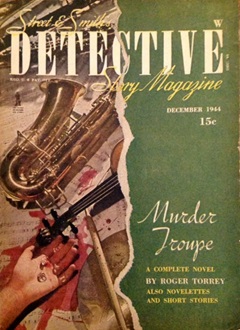
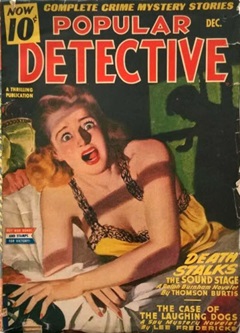
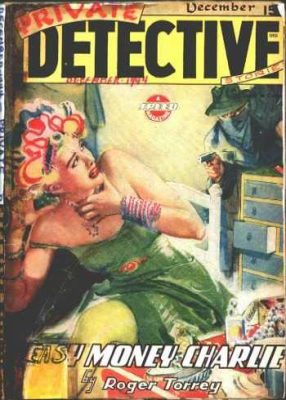
To view the entire list of weekly Old Time Radio episodes at Tangent Online, click here.